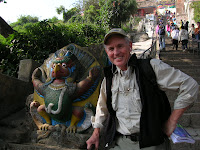Here's a brief description of the work Habitat is doing in Nepal:
HOME TO T H E MA J E S T I C Mount Everest, landlocked Nepal is also one of the poorest countries in the world. The majority of Nepalese live in villages and are dependent on agriculture, but severe floods, landslides and earthquakes threaten homes, fields and livestock.
A lack of employment and poverty has forced one in 10 of the rural population to migrate to the capital Kathmandu and other municipalities. A decade-long rebel insurgency has also driven people from villages to the cities in search of safety. Migration and urban growth have resulted in shortage of adequate housing in towns and cities, crowded living spaces and the growth of sub-standard housing. According to government data, nearly 430,000 families live in sub-standard housing.
Sub-standard housing frequently means structures with thatched roofs and straw walls, sometimes supported by pillars made of bamboo or old timber. Water is often unsanitary and few dwellings have toilets or electricity. These dilapidated houses are also a fire risk; nearly 10,000 families lose their homes to fire every year.
Habitat also partners microfinance institutions (MFI) to build houses using the Save & Build and Build in Stages housing microfinance models. MFI partners include co-operative bank Sahara Nepal, Nari Bikash Sangh, an NGO that is involved in the empowerment of rural poor and disadvantaged women, and village banks through Samjhauta Nepal’s links. 
Each core house, 26 sq. m. in size, is constructed using cost-effective bamboo and “green” bricks. In Nepal, indigenous bamboo is suitable for use in house construction as it grows fast, is easy to use, environmentally friendly and durable. Bamboo can be used as poles, doors, windows, mats for wall and ceiling, and fence-posts. “Green” bricks are made of clay and unlike bricks burnt with firewood; they do not contribute to air pollution. The rural community can turn to growing and harvesting bamboo, and making “green” bricks as income-generating activities. Nepali homeowner Pratibha Adhikari in front of her Habitat house with her daughter Sostika.
Each home partner family contributes sweat equity, or their own labor, in building their own house as well as those of others. Families also provide raw materials to reduce the loan they have to repay. The mortgage loan repayment period is less than three years and repayment averages US$7 per month.








